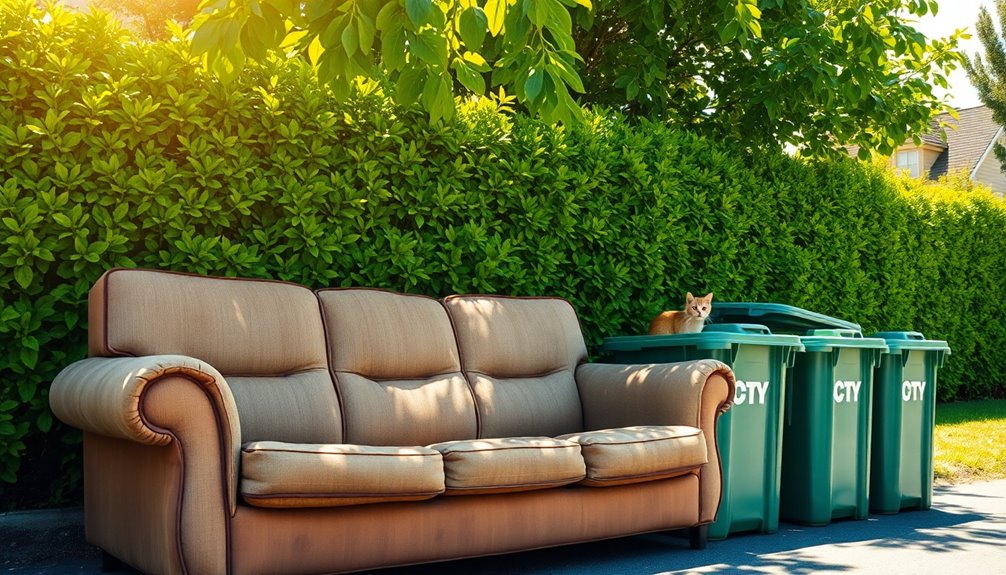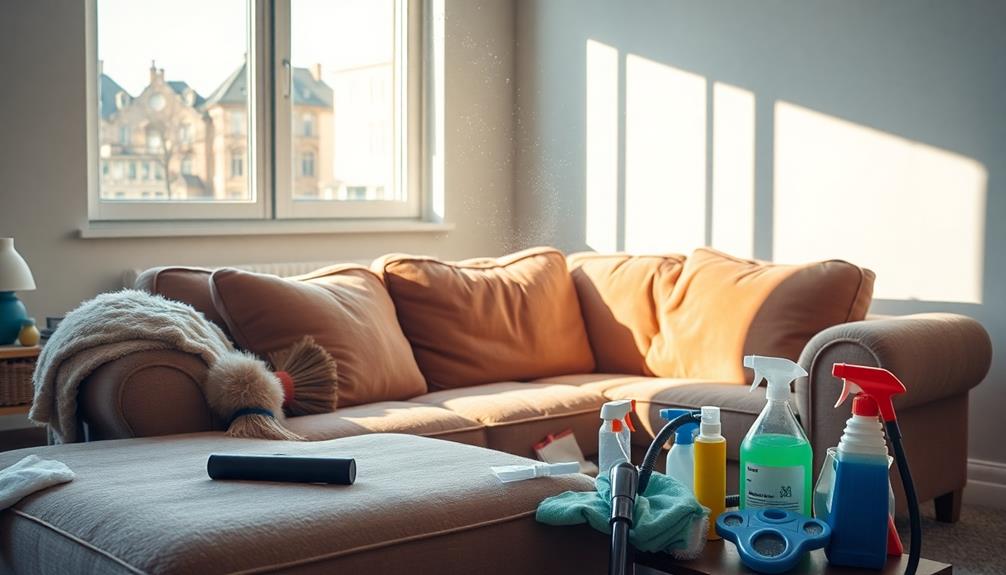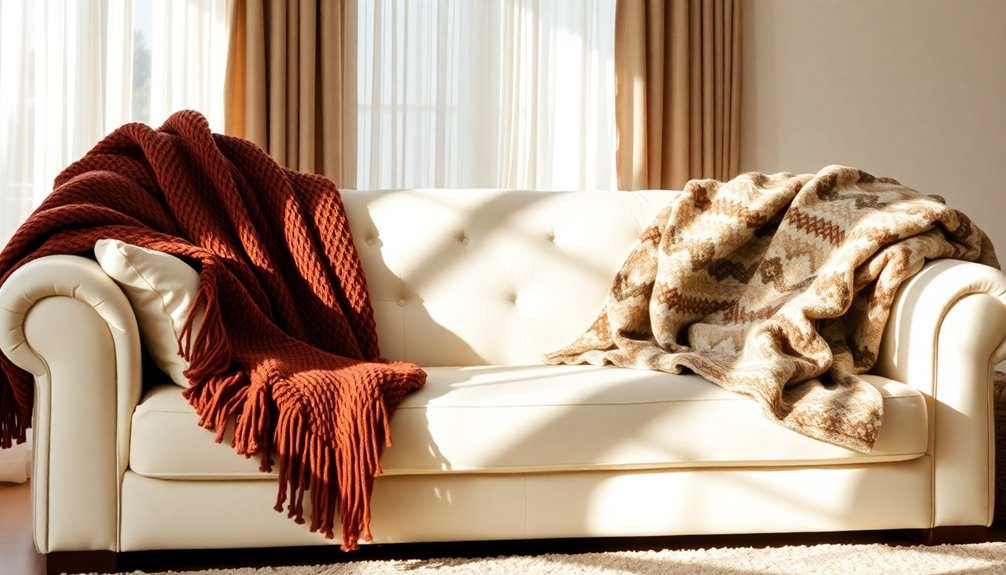When it's time to dispose of your old sofa, start by checking local regulations for bulk item pick-ups. If it's still in decent shape, consider donating it to a charity or giving it away online. Many organizations offer free pick-up services for gently used furniture. If the sofa's beyond repair, contact a local junk removal service to ensure it's disposed of responsibly. You can also explore recycling options at facilities that handle furniture. Each method will help you part ways with your sofa while following proper guidelines, and there's more to discover about each option as you go.
Key Takeaways
- Check local regulations for disposal options, as some areas have specific rules for furniture disposal to avoid fines.
- Donate gently used sofas to charities that offer pickup services, benefiting those in need while reducing waste.
- Schedule a bulk waste pickup with your local waste management service, ensuring they accept furniture items.
- Consider recycling options if available; some facilities may take upholstered materials for repurposing.
- If the sofa is beyond repair, disassemble it before disposal to make it easier to transport and reduce landfill space.
Introduction
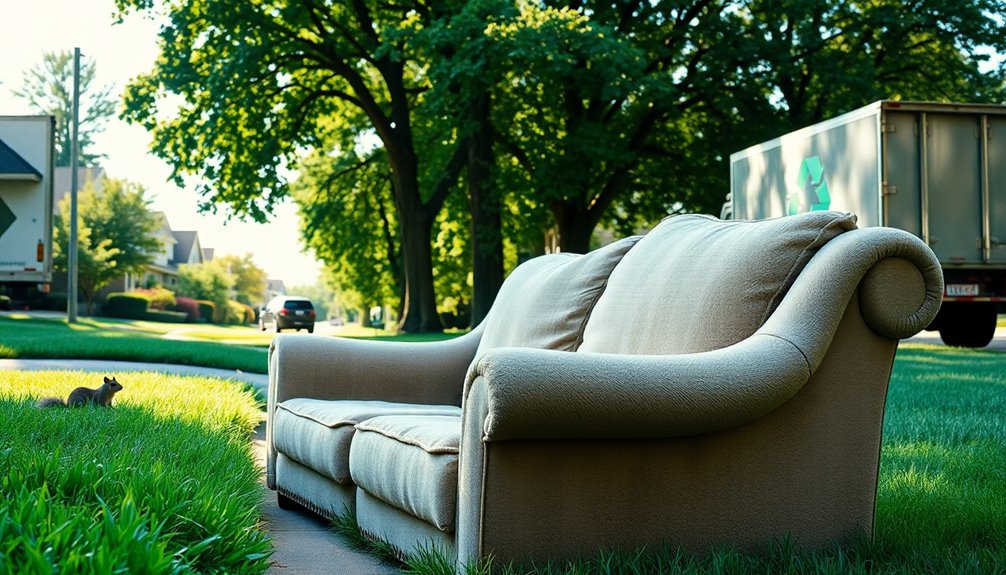
When it comes to keeping your sofa in good shape, routine dusting and vacuuming are key. You'll also want to learn fabric-specific cleaning techniques to tackle stains effectively, especially those pesky red wine spills. Taking these steps not only maintains your sofa but also prepares it for a successful disposal when the time comes.
Routine Dusting and Vacuuming
Keeping your sofa clean is essential for maintaining a healthy living space. Regular routine dusting helps remove surface dirt and allergens, contributing to a cleaner environment. By vacuuming your sofa at least once a week, you can prevent dust buildup and extend the lifespan of the upholstery.
To vacuum effectively, use a vacuum with an upholstery attachment. This tool can reach into crevices, removing pet hair, crumbs, and debris that often accumulate. Make sure to pay attention to the seams and hidden areas where dust tends to hide.
In addition to routine dusting and vacuuming, consider using a microfiber cloth with a gentle fabric cleaner for spot cleaning any stains. This way, you preserve the fabric's integrity while keeping your sofa looking fresh.
Fabric-Specific Cleaning Techniques
Understanding your sofa's fabric is crucial for effective cleaning and maintenance. Different fabric types require specific cleaning methods. For instance, microfiber can often be cleaned with a mixture of water and mild detergent, while leather needs special leather cleaners or conditioners to avoid damage. Always check the manufacturer's care label to find the appropriate cleaning solvents and determine whether to use water-based or solvent-based cleaners.
When it comes to stain removal, you should blot the affected area gently with a clean cloth and a suitable cleaning solution. Rubbing can spread the stain or harm the fabric, so it's best to be cautious. Regular maintenance, including vacuuming with an upholstery attachment and applying fabric protectants, can help prolong your sofa's life and prevent deep-set stains from forming.
For stubborn odors or more profound cleaning needs, consider using a steam cleaner, ensuring it's compatible with your specific fabric type to avoid shrinkage or damage. By following these fabric-specific cleaning techniques, you'll maintain your sofa in excellent condition and extend its lifespan. Additionally, maintaining good indoor air quality through air purifiers can help prevent odors from settling into your upholstery, ensuring a fresher living environment.
Treating Red Wine Spills
If you've ever enjoyed a glass of red wine while relaxing on your sofa, you know how quickly a spill can turn into a nightmare. The first thing you should do is grab a clean, dry cloth and gently blot the stain. Avoid rubbing, as this can spread the wine further into the fabric. Once you've absorbed as much as possible, sprinkle some salt or baking soda over the stain; these will help absorb the remaining wine.
For a deeper clean, mix one part dish soap, one part white vinegar, and two parts water in a spray bottle. Lightly spray this solution onto the stain and blot it again with a clean cloth. If the stain still lingers, consider using a commercial upholstery cleaner that matches your sofa's fabric, always testing it on a hidden area first.
Avoid Direct Sunlight Exposure
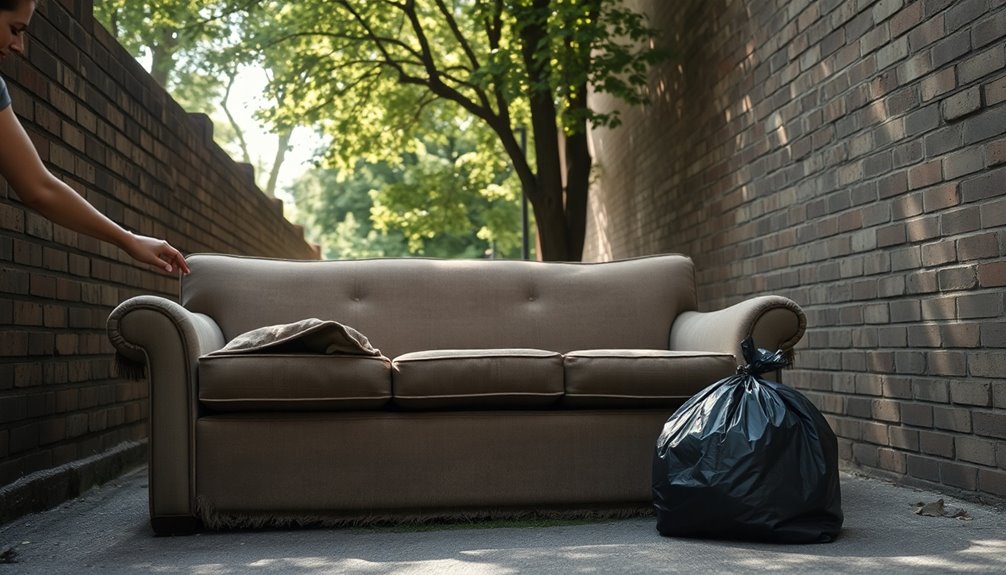
To keep your old sofa in good shape before disposal, you need to protect it from direct sunlight. Consider scratch-resistant fabric choices and stylish covers that not only shield against UV rays but also enhance your decor. Regularly rotating cushions can also help maintain their appearance and prevent uneven wear.
Scratch-Resistant Fabric Choices
Durability is key when selecting fabrics for your sofa, especially if you have pets or a busy household. Scratch-resistant fabrics like microsuede and leather are excellent choices, as they resist wear and tear, ensuring your furniture withstands daily use. Additionally, fabrics with a tight weave, such as canvas or nylon, further minimize the risk of scratches and damage over time.
While considering your options, remember that avoiding direct sunlight exposure is crucial. UV rays can fade and weaken fabric fibers, leading to premature wear. To keep your sofa looking fresh, regular cleaning and maintenance are essential. Vacuuming and using protective sprays can help preserve the appearance and integrity of scratch-resistant fabrics, extending the life of your investment.
If you ever need to dispose of old furniture, consider how the fabric choice impacts its longevity. When selecting a new sofa, you might also look for options treated with stain repellents, which enhance resilience against scratches. By making informed decisions about scratch-resistant fabrics, you can enjoy a stylish and durable sofa that fits your lifestyle without frequent replacements.
Stylish Fabric Protection Options
Protecting your sofa's fabric from fading is a smart move, especially when you want to maintain its appearance over time. Start by placing your sofa away from direct sunlight. If that's not possible, consider using window treatments like sheer curtains or UV-blocking shades to diffuse the light. These options not only enhance your room's style but also shield your fabric from harmful rays.
Applying a fabric protector spray creates a barrier against stains and UV rays, extending the life of your upholstery while preserving its color and texture. Look for products specifically designed to offer UV resistance, which are especially beneficial if your sofa's fabric is susceptible to fading.
If you're looking for new furniture, opt for fabrics designed with UV resistance, such as solution-dyed acrylics, as they're less likely to fade over time. Additionally, try arranging your sofa in a room where natural light only comes in during specific hours. This way, you'll minimize sun exposure and protect your investment, allowing your sofa to resist the wear and tear often seen with old appliances. By following these tips, you'll keep your sofa looking stylish for years to come.
Regularly Rotate Cushions
Your sofa's cushions deserve regular attention to maintain their shape and comfort. To prolong the life of your old furniture, make it a habit to rotate and flip the cushions every few weeks. This simple practice helps distribute wear evenly, preventing uneven sagging and permanent indentations that can occur when one side gets all the action.
Additionally, be mindful of sunlight exposure. UV rays can cause fabric colors to fade and weaken the material over time. If your sofa's cushions are often placed in direct sunlight, consider using protective covers or slipcovers. These can shield your furniture from harmful rays and general wear, keeping it looking fresh and intact longer.
Upholstery Stitching and Patching
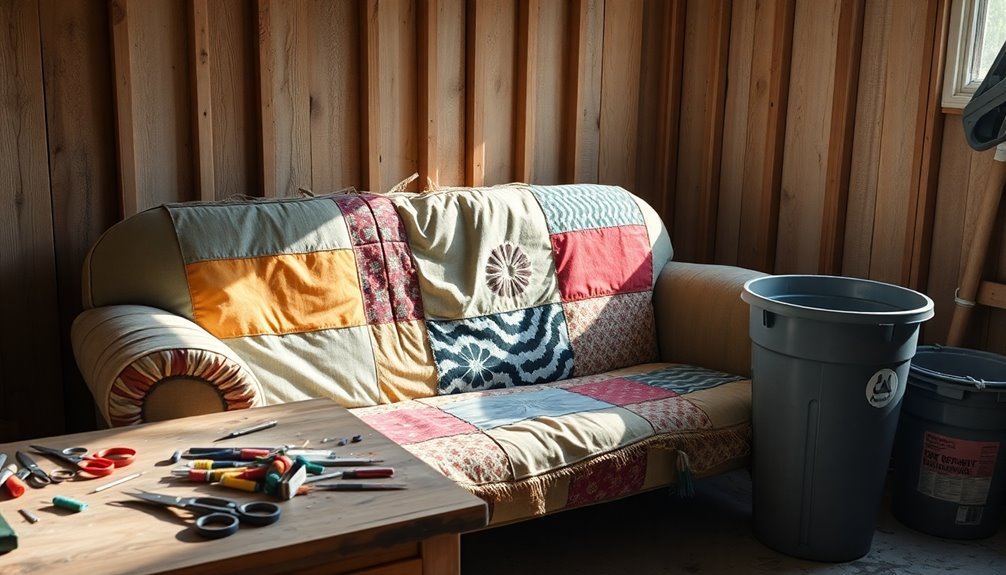
When it comes to upholstery stitching and patching, you might want to think about the integrity of your sofa's frame. Fixing up minor damages not only rejuvenates your furniture but can also uplift your living space with a fresh look. If you're unsure about tackling this yourself, professional services can ensure quality repairs that keep your sofa looking great and structurally sound.
Frame Integrity Concerns
How can you tell if a sofa's frame is still sturdy enough for everyday use? Start by checking for any signs of sagging or broken supports. These issues can indicate compromised frame integrity, making the sofa less usable. If you notice any instability, it might be time to consider repairs or even disposal.
Next, examine the upholstery stitching. Look for fraying or loose threads, as these can lead to further deterioration. Minor tears can sometimes be patched, but ensure the patch material matches both in texture and color to keep the sofa looking good.
However, if the frame has significant damage, like cracks or breaks in the wood, repairs may not be worth the cost. In such cases, it might be more sensible to dispose of the sofa rather than invest in extensive repairs that won't guarantee longevity.
Regular maintenance, such as tightening screws and re-stapling loose upholstery, can help prolong your sofa's life and prevent frame integrity issues from developing. By staying proactive, you can make informed decisions about whether to repair or dispose of your old sofa.
Reupholstering for a Fresh Look
If frame integrity issues lead you to consider giving your sofa a new life, reupholstering can be a smart choice. Not only does it extend the life of your old sofa, but it also provides a fresh aesthetic. Costs typically range from $600 to $1,200, depending on your fabric choice and labor involved.
When tackling upholstery stitching, you'll focus on sewing loose or damaged seams, restoring the sofa's structural integrity. Make sure to use specialized upholstery thread for added durability. For smaller issues like holes or tears, patching is an effective technique. By sewing in a matching fabric piece, you can maintain your sofa's appearance without committing to a full reupholster.
Many upholstery services offer a variety of fabric options, including eco-friendly materials, allowing you to customize the look while being mindful of the environment. Additionally, regular maintenance—like cleaning and re-stitching—can prevent more extensive damage. This makes reupholstering not just a repair but a cost-effective solution for those bulky items that still hold value in your home. Incorporating natural materials like wood and stone into your decor can enhance the overall farmhouse aesthetic, complementing your newly upholstered sofa beautifully.
Uplifting Your Living Space
Transforming the look of your living space can be as simple as addressing the wear and tear on your sofa through upholstery stitching and patching. Small tears or worn areas can be effectively repaired, extending your sofa's lifespan while improving its appearance. Grab a needle and thread designed for upholstery to ensure durability, preventing further fraying.
Before you start, clean the damaged area thoroughly; this helps the stitching or adhesive adhere properly. You can patch the sofa using fabric that matches the original upholstery or opt for contrasting fabrics to create a unique aesthetic. If you encounter significant damage, don't hesitate to consult a professional upholsterer for comprehensive repairs or complete reupholstering.
After revitalizing your sofa, if you find it still doesn't fit your style, consider using junk removal services or visiting local donation centers. Many local charities accept furniture donations, allowing you to uplift someone else's living space while clearing yours. By making these thoughtful choices, you not only enhance your home but also contribute to your community. Additionally, selecting neutral color palettes can further harmonize your decor and create a cohesive look throughout your living space.
Personalized Fabric Choices
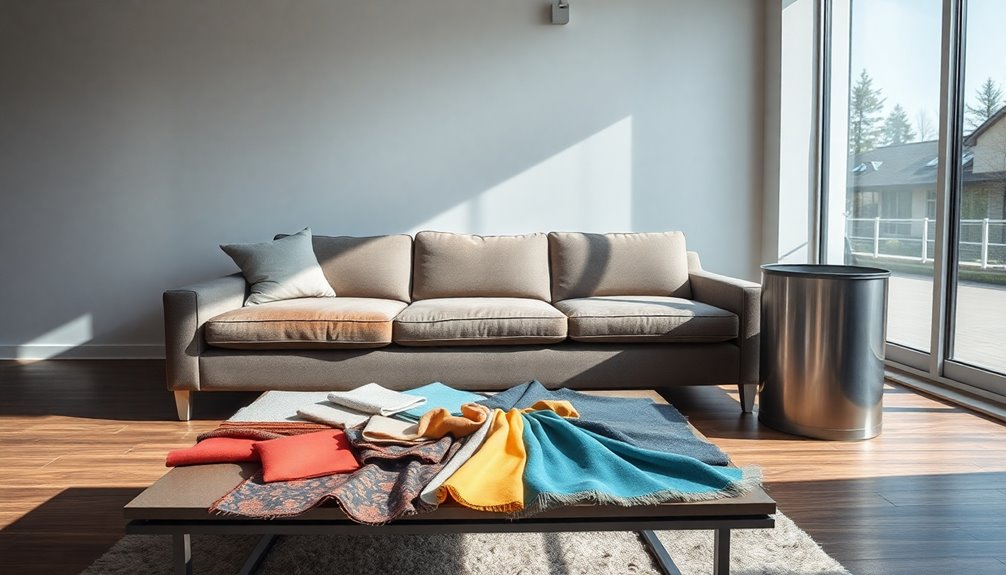
Often, selecting the right fabric for reupholstering your old sofa can feel overwhelming, but it doesn't have to be. Start by considering your options, like cotton, linen, polyester, or leather, each offering unique aesthetics and durability levels. Think about how these fabrics will fit into your existing decor. The right pattern and color can enhance the ambiance of your living space.
If you're concerned about the environment, opt for eco-friendly fabrics made from recycled materials or organic fibers. These choices not only look great but also contribute to sustainability efforts and reduce your environmental impact. If you have pets or children, performance fabrics are an excellent choice. They're designed to resist stains and wear, ensuring your reupholstered sofa will stand the test of time.
Don't hesitate to engage a professional upholsterer. They can provide expert advice tailored to your sofa's style, usage, and desired longevity. With their help, you can make informed fabric choices that meet your needs while transforming your old sofa into a stunning centerpiece for your home.
Seasonal Maintenance Tips
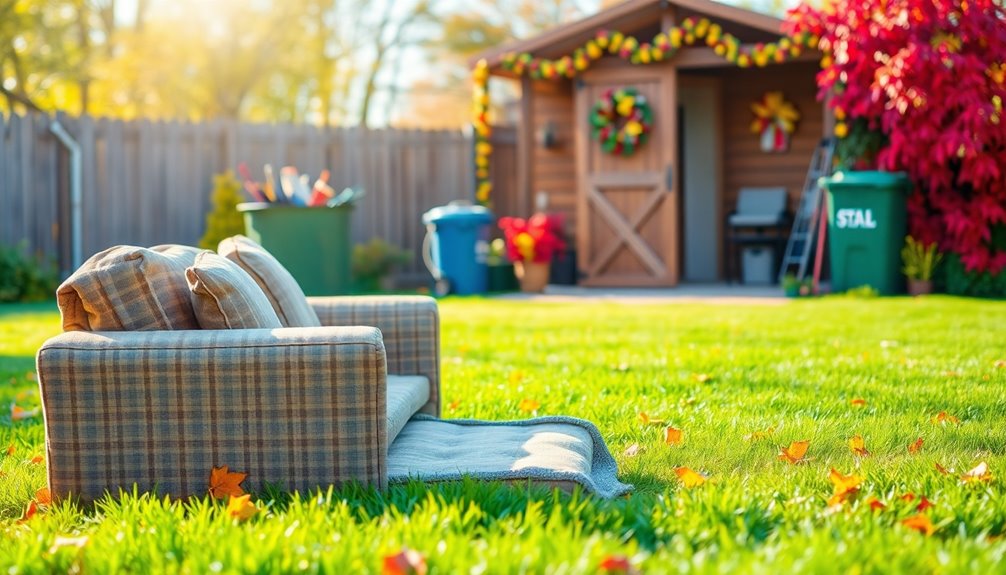
Maintaining your old sofa throughout the seasons can significantly extend its lifespan and keep it looking fresh. Regularly check for signs of wear, like upholstery stains, tears, or even pest infestations. If you spot any issues, determine whether a repair is possible or if it's time to consider disposal.
Incorporate seasonal cleaning into your routine. Vacuum your sofa regularly and use an upholstery cleaner to maintain its appearance and hygiene. During humid months, inspect for mold or mildew, addressing any problems promptly to prevent further damage.
If you're thinking about disposal in spring or fall, many charities and local services offer free pickup for gently used couches during these seasons. This is a great way to give your sofa a second life while also decluttering your space. Just remember to follow local disposal regulations to avoid fines, especially when placing your sofa out for curbside pickup during seasonal cleanouts.
Conclusion
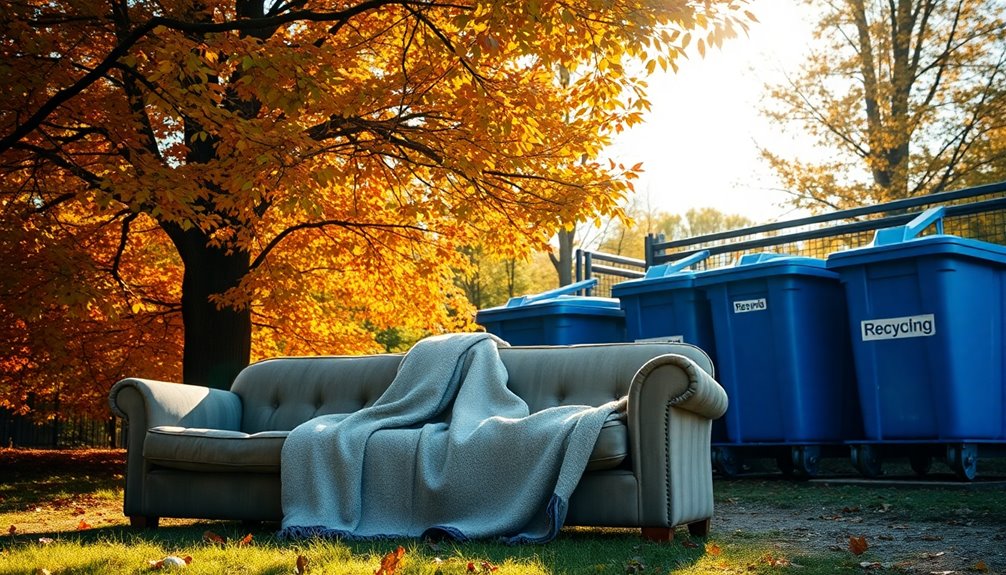
When it comes to disposing of your old sofa, it's essential to explore all available options before making a decision. Donating your gently used sofa to local charities like Goodwill or Habitat for Humanity can positively impact those in need while giving your furniture a second life. Many of these organizations even offer pickup services, making the process effortless for you.
If your sofa is beyond repair or severely damaged, consider taking it to a recycling center that specializes in furniture. This way, you can ensure that as much material as possible is recycled rather than ending up in a landfill.
Alternatively, if you want a hassle-free solution, hiring junk removal services is a great option. These services typically charge based on volume or weight and can take care of the heavy lifting and transportation for you.
Before you decide, think about whether reupholstering or repairing the sofa might extend its life or increase its resale value. Ultimately, whatever method you choose, ensure that you're disposing of your old sofa responsibly, keeping both your needs and the environment in mind.
Frequently Asked Questions
How to Get Rid of an Old Sofa?
When you're looking to get rid of an old sofa, consider a few options. You could donate it to a local charity or schedule a pickup with a junk removal service for a hassle-free experience. If you're into DIY, check local recycling centers or dismantle it for transport. Selling it online through platforms like Facebook Marketplace can also work well. Lastly, contact your waste management service to see if they pick up bulky items.
How Do I Get Rid of a Large Couch in My House?
To get rid of a large couch in your house, start by checking local junk removal services that offer easy pickup options. If your couch is in decent shape, consider donating it to charities that may even pick it up for you. Alternatively, you could dismantle it for easier transport or sell it online through platforms like Craigslist. Just make sure you communicate clearly with buyers for a smooth pickup process.
What Can You Do With a Broken Couch?
If you've got a broken couch, you've got a few options. You can contact local junk removal services for safe disposal, often with same-day pickups. Consider recycling parts at a nearby center; they might accept wood and fabric. If the damage's minimal, think about donating it to a charity that can repair it. Alternatively, you can dismantle the couch to salvage usable components, making disposal easier and more eco-friendly.
How to Get Rid of a Couch in LA?
If you’re looking to get rid of a couch in LA, you’ve got several options. You can schedule a bulky item pickup through the city’s sanitation department on your trash collection day. If your sofa’s in good shape, consider donating it to a local charity like Goodwill, which might even pick it up. For quick disposal, hiring a junk removal service can ensure a fast and responsible solution. Check local regulations to avoid fines. Additionally, if you’re interested in a more eco-friendly approach, you can explore local recycling options or participate in furniture exchange programs where your couch can find a new home. Many people also turn to online marketplaces to sell or give away their old furniture, providing a simple way to declutter while helping someone in need. Understanding how to get rid of furniture efficiently can make the process smoother and prevent unnecessary waste.
